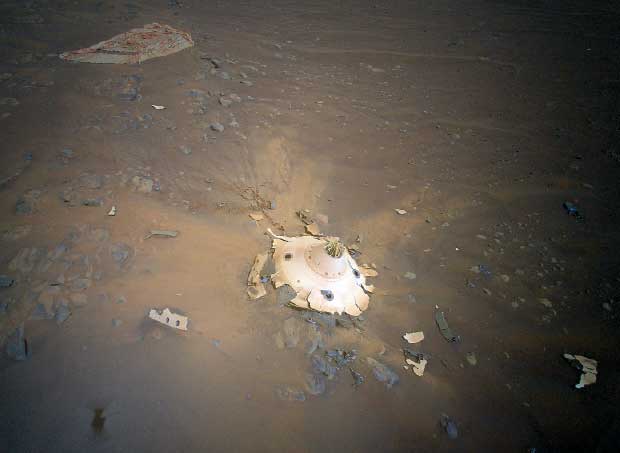When should we start thinking about cleaning up our space junk on Mars?
When should we start thinking about cleaning up our space junk on Mars?

NASA / JPL-Caltech
Shards of alien metal lie strewn about the crash site of a derelict contraption from another planet, the remains of an intricately machined saucer sent by a strange and distant civilization. . . .
Ours.
In April, NASA’s Ingenuity helicopter, which is tagging along with the Perseverance rover, returned hauntingly surreal photographs of the rover’s own discarded “backshell,” the cover of its entry vehicle. As the rover descended to the Martian surface on February 18th of last year, the backshell was jettisoned and came to rest, largely intact but smashed around the edges, atop the shifting red sands.
My first thought on seeing the image above was “Cool!” It’s still very hard to fly something to Mars, and now to finally fly something on Mars, not to mention use it to survey our own wreckage from the air — that is next-level cool. It’s also useful: The forensics of the crash can help us improve future landing craft.
My second thought was “Beautiful!” If Mars has never had life (open question) or, as seems likely, any of its own cultures to create art or technology, then arguably there’s something wonderful about finally bringing these to the planet.
But my third thought was to wonder when we will start picking up after ourselves. Some readers will consider it ridiculous to ask. Others will consider it ridiculous not to ask. They’re both right. It’s just a question of time scale and perspective.
To worry about this right now seems silly. It’s like asking the first sea creatures that wriggled onto a shoreline of Earth’s barren continents billions of years ago to erase their tracks. Mars is so vast, unexplored, and utterly empty of artifacts, and our efforts are so tentative and puny. But a few thousand years ago, our own planet seemed so huge compared to any of our creations or influences that it would have seemed silly then to think we could meaningfully perturb or pollute it.
In a later era that I’ve called the “immature Anthropocene,” we started to significantly alter our planet but remained ignorant of the fact that we could. Finally, as our numbers and influence grew, we learned that there was no throwing things “away,” that we inhabit a finite and mutable world.
Our maturity as a species is tied to our recognition that we are a planet-changing species and must learn to act accordingly. Integrating this realization into our global-scale activities will be at least as essential to our long-term survival as becoming a multi-planet species might someday be.
We are obviously a long way from filling up Martian craters with our debris, bacteria, and effluence. I bet it will be many generations before humans live on the Red Planet in sufficient numbers to have a self-sustaining presence and make our mark to any significant degree.
But at what point in the future should we concern ourselves with this? If we imagine that someday we’ll build cities and civilizations there, then clearly “never” is the wrong answer.
Mars is not an escape hatch for a ruined Earth. It could, however, serve as a model for how we engage with a planet from the beginning, with a long-term plan and ourselves in the picture. Perhaps interacting thoughtfully with Mars, as opposed to inadvertently and haphazardly, can even help us care for our home world both before and after some of us do eventually leave our comfortable blue-and-green Earth for the challenging lands beyond.
Ad astra cum conscientia.
This article originally appeared in print in the September 2022 issue of Sky & Telescope. Subscribe to Sky & Telescope here.
 2
2
Comments
Anthony Barreiro
June 10, 2022 at 5:04 pm
Thank you for this thought provoking essay. I hope that any future human visitors to Mars would cherish these artifacts as archaeological treasures.
These questions are more pressing on the Moon. Several nation states and grandiose corporate overlords are planning to exploit the Moon for national pride and/or commercial gain, while historians are trying to establish formal protections for the Apollo landing sites, etc. How long until Neil Armstrong's bootprints are obliterated by tourists taking selfies? How long until somebody brings bits of the Eagle back to Earth as souvenirs, or to sell to the highest bidder? I'm with the historians on this one.
The international treaties about what can and can't be done on Antarctica can serve as a template for similar agreements about how humans (and our robotic emissaries) visit the Moon, Mars, and other heavenly bodies.
You must be logged in to post a comment.
morgan
June 10, 2022 at 6:06 pm
Glad to see that someone feels as I do - that our space junk should be removed. Human beings are five star polluters and natural forces cannot keep up with the amount of garbage we create. My thinking has gone so far as to believe that we humans are parasites on our host planet. Planet earth has given us so much but we just continue to trample and spit on it. In view of our current behavior we do not deserve to go into space. It is some comfort that even if climate change doesn't cause the extinction of humans, thereby ending their lack of stewardship, the vagaries of the universe will ultimately have the final word.
You must be logged in to post a comment.
You must be logged in to post a comment.